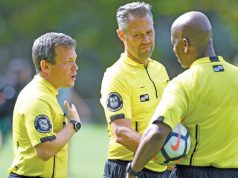The Laws of the Game allow for the dismissal of a team official (e.g., coach, assistant coach or athletic trainer) if that person’s behavior is deemed “irresponsible.” In general, the term “irresponsible” includes many of the things a player is not allowed to do, including committing dissent, using abusive or offensive language, or entering the field during play without permission. To assist referees, U.S. Soccer developed the “Ask, Tell, Dismiss” protocol for handling real-world situations, with the proviso that jumping directly to the second or third step was always permitted if circumstances required it.
But what if it doesn’t work? “Dismiss” is operationally defined as being “out of sight, out of sound,” meaning the dismissed coach must move far enough away from the game site to not be seen or heard. So, point one is that, upon receiving the order to leave, you should not restart the game until that basic requirement has been adhered to. Be firm. You have the ultimate decision to simply not restart play until that basic condition has been met. If others involved in the match want to play, it is likely they will become, no matter how reluctantly, your allies in getting the recalcitrant coach to leave.
It is not recommended that you immediately jump to stating conditions but you can hold in reserve the public statement that after a reasonable amount of time has passed with no departure of the dismissed coach that the game will be terminated if you don’t receive compliance. Don’t say this publicly unless you are willing to do it.
OK, the coach is gone — out of sight and sound — and then reappears! You can see and/or hear the coach. What now? You have two options depending on the overall “feel” of the situation but both involve suspending play again. Either stop to terminate the match or stop to re-dismiss the coach, but don’t lose any time in the stopping itself. Although your match report will already be including details of the original dismissal, all the facts and circumstances of this re-occurrence must be included as well. And if you choose to give the coach a second chance followed by a restart of play once the coach again is out of sight and sound, and once again the coach returns, move to an immediate termination of the game. Enough is enough.
Once the match is over, your formal authority to dismiss is also over and so the coach is no longer required to be out of sight and sound. However, as long as you remain in the area of the field taking care of wrapping things up, you retain the right and responsibility to include in your game report any further irresponsible behavior by the previously dismissed coach or by any other team official, just as you can for comparable behavior by a player.
By itself, the “Ask, Tell, Dismiss” protocol is a useful guideline for handling team officials, but you also need to be aware of your options if that protocol doesn’t result in the team official staying dismissed.
What's Your Call? Leave a Comment:
Note: This article is archival in nature. Rules, interpretations, mechanics, philosophies and other information may or may not be correct for the current year.
This article is the copyright of ©Referee Enterprises, Inc., and may not be republished in whole or in part online, in print or in any capacity without expressed written permission from Referee. The article is made available for educational use by individuals.
















